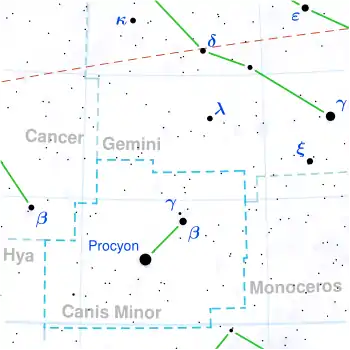HD 66141
HD 66141 is a single[7] star in the equatorial constellation of Canis Minor. It has the Bayer designation G Canis Minoris, the Gould designation 50 G. Canis Minoris,[6] and has the HR 3145 identifier from the Bright Star Catalogue.[5] When first catalogued it was in the Puppis constellation and was designated "13 Puppis", but it subsequently migrated to Canis Minor.[8] Bode gave it the Bayer designation of Lambda Canis Minoris.[9]
 | |
| Observation data Epoch J2000.0 Equinox J2000.0 | |
|---|---|
| Constellation | Canis Minor |
| Right ascension | 08h 02m 15.93659s[1] |
| Declination | +02° 20′ 04.4522″[1] |
| Apparent magnitude (V) | +4.39[2] |
| Characteristics | |
| Spectral type | K2IIIbFe-0.5:[3] |
| B−V color index | 1.252±0.008[2] |
| Astrometry | |
| Radial velocity (Rv) | +71.57±0.01[2] km/s |
| Proper motion (μ) | RA: −28.63[1] mas/yr Dec.: 105.27[1] mas/yr |
| Parallax (π) | 12.84 ± 0.25 mas[1] |
| Distance | 254 ± 5 ly (78 ± 2 pc) |
| Absolute magnitude (MV) | −0.07[2] |
| Details[4] | |
| Mass | 0.98±0.06 M☉ |
| Radius | 21.43±1.18 R☉ |
| Luminosity | 166+43 −34 L☉ |
| Surface gravity (log g) | 2.09±0.06 cgs |
| Temperature | 4,328±21 K |
| Metallicity [Fe/H] | −0.52±0.05 dex |
| Rotational velocity (v sin i) | 1.91±0.45 km/s |
| Age | 9.18±2.09 Gyr |
| Other designations | |
| Database references | |
| SIMBAD | data |
| Exoplanet Archive | data |
| Extrasolar Planets Encyclopaedia | data |
Properties
This star has an orange hue and is bright enough to be faintly visible to the naked eye on a dark night, having an apparent visual magnitude of +4.39.[2] It is located at a distance of approximately 254 light years from the Sun based on parallax,[1] and is drifting further away with a radial velocity of +71.6 km/s.[2] The star is considered a member of the thin disk population.[4] It has one known exoplanet companion.[10]
The stellar classification of HD 66141 is K2IIIbFe-0.5:,[3] which indicates an evolved K-type giant star with a mild underabundance of iron. It is an estimated nine billion years old with 0.98 times the mass of the Sun and has expanded to 21 times the Sun's radius.[4] Over 2003 to 2012 a starspot was periodically dimming its light.[10] The star is radiating 166 times the luminosity of the Sun from its photosphere at an effective temperature of 4,328 K.[4]
A magnitude 10.32 visual companion was reported by J. Glaisher in 1842. As of 2015, it was located at an angular separation of 224.90 arcseconds along a position angle of 315°.[11]
Planetary system
From December 2003 to January 2012, the team B.-C. Lee, I. Han, and M.-G. Park observed "HD 66141" with "the fiber-fed Bohyunsan Observatory Echelle Spectrograph (BOES) at Bohyunsan Optical Astronomy Observatory (BOAO)".[10]
In 2012, a long-period, wide-orbiting planet was deduced by radial velocity. This was published in November.
| Companion (in order from star) |
Mass | Semimajor axis (AU) |
Orbital period (days) |
Eccentricity | Inclination | Radius |
|---|---|---|---|---|---|---|
| b | >6 ± 0.3 MJ | 1.2 ± 0.1 | 480.5 ± 0.5 | 0.07 ± 0.03 | — | — |
References
- Van Leeuwen, F. (2007). "Validation of the new Hipparcos reduction". Astronomy and Astrophysics. 474 (2): 653–664. arXiv:0708.1752. Bibcode:2007A&A...474..653V. doi:10.1051/0004-6361:20078357. S2CID 18759600.
- Anderson, E.; Francis, Ch. (2012). "XHIP: An extended hipparcos compilation". Astronomy Letters. 38 (5): 331. arXiv:1108.4971. Bibcode:2012AstL...38..331A. doi:10.1134/S1063773712050015. S2CID 119257644.
- Keenan, Philip C.; McNeil, Raymond C. (1989). "The Perkins catalog of revised MK types for the cooler stars". The Astrophysical Journal Supplement Series. 71: 245. Bibcode:1989ApJS...71..245K. doi:10.1086/191373.
- Jofré, E.; et al. (2015). "Stellar parameters and chemical abundances of 223 evolved stars with and without planets". Astronomy & Astrophysics. 574: A50. arXiv:1410.6422. Bibcode:2015A&A...574A..50J. doi:10.1051/0004-6361/201424474. S2CID 53666931.
- "G CMi". SIMBAD. Centre de données astronomiques de Strasbourg. Retrieved 2021-01-27.
- Gould, Benjamin Apthorp (1879). "Uranometria Argentina catalog of bright southern stars". Resultados del Observatorio Nacional Argentino en Cordoba. Buenos Aires. 1. Bibcode:1879RNAO....1.....G. Retrieved 2021-01-27.
- Eggleton, P. P.; Tokovinin, A. A. (September 2008). "A catalogue of multiplicity among bright stellar systems". Monthly Notices of the Royal Astronomical Society. 389 (2): 869–879. arXiv:0806.2878. Bibcode:2008MNRAS.389..869E. doi:10.1111/j.1365-2966.2008.13596.x. S2CID 14878976.
- Griffin, R. F. (1999). "Spectroscopic binary orbits from photoelectric radial velocities. Paper 148: HR 7955". The Observatory. 119: 272–283. Bibcode:1999Obs...119..272G.
- Wagman, Morton (2003). Lost Stars: Lost, Missing and Troublesome Stars from the Catalogues of Johannes Bayer, Nicholas Louis de Lacaille, John Flamsteed, and Sundry Others. p. 460. Bibcode:2003lslm.book.....W. ISBN 978-0-939923-78-6.
{{cite book}}:|journal=ignored (help) - Lee, B.-C.; et al. (2012). "Detection of an exoplanet around the evolved K giant HD 66141". Astronomy & Astrophysics. 548: A118. arXiv:1211.2054. Bibcode:2012A&A...548A.118L. doi:10.1051/0004-6361/201118014. S2CID 54984721.
- Mason, B. D.; et al. (2014). "The Washington Visual Double Star Catalog". The Astronomical Journal. 122 (6): 3466–3471. Bibcode:2001AJ....122.3466M. doi:10.1086/323920.